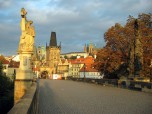The National Museum in Prague is a Czech institution that was designed for creating, preparing and exhibiting historical and natural scientific collections. Kašpar Maria Šternberg founded the museum in 1818, and František Palacký, a renowned historian, also helped. The National Museum exhibits nearly fourteen million objects that are related to history, natural history, music, and arts which are located several buildings. Currently, the museum in Prague is closed until 2016, because of major renovations.
The Building
The exterior of the museum is very distinctive because of its size. The interior is very attractive, particularly the impressive pantheon and large staircase hall that honors many Czech figures. The hall has a very beautiful glass dome. The vaults have been ornately decorated with beautiful frescoes and adornments.
In 1945, the museum was damaged by a bomb, but no collections were damaged since they had been transferred to safe storage sites. The National Museum in Prague reopened following extensive repairs in 1947. In 1968, during the Warsaw Pact, the building’s main facade was seriously damaged by Soviet machine-gun fire. Many stone reliefs and statues were damaged, as well as some of the depositaries. In spite of the 1970’s repairs, damage is still visible since the repairs were done with lighter sandstone.
Exhibitions
In addition to temporary exhibitions, this museum has permanent displays on anthropology, biology, geology, mineralogy, decorations and numismatics. There is also a regional history exhibition. The museum had various departments which include the Department of Theater and the Department of Ethnography.
Museum History
The first president of the museum was Count Sternberk, who also served as the operator and trustee. In the early stages, the main objective of the museum had been focused on natural sciences, to a certain extent due to the fact that Count Sternberk was a mineralogist, botanist, and eminent phytopaleontologist.
In the 1830’s and 1840’s the museum became interested in acquiring historical objects when Romanticism became very popular. The National Museum soon became the central location for Czech nationalism. Frantisek Palacky, served as secretary and historian for the museum in 1841. He tried to balance history and natural science, but not until nearly one hundred years later did the museum’s historical pieces equal its natural science collection.
During the 1880’s, Bohemian nobility had been very prominent, both fiscally and politically in scholarly, as well as scientific groups. The museum was designed to serve all citizens of the country in order to remove the control that the aristocracy had on learning and knowledge. This concept was accelerated when Palacky suggested that the museum’s journals be published in not only German, but also in Czech. Earlier, almost all scholarly journals had been only published in German. A short time later, the German journal was no longer published, while the Czech journal continued being published for another one hundred years.
In 1949 the national government took control of the museum and explained its leadership role in the 1959 Museum and Galleries Act. In May of 1964, the museum became an institution of five autonomous units which are the Historical Museum, Natural Science Museum, Naprstek Museum of African, American and Asian Cultures, the Museology Central Office and the Library of the National Museum. Another autonomous organization, the Czech Music Museum, was founded in 1976.























